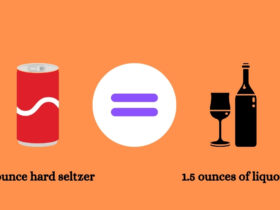Have you ever wondered how long alcohol stays in your system after just one drink? The answer is surprisingly straightforward: it can take about one hour for the body to process the alcohol in one standard drink (0.6 ounces of pure alcohol). But there’s more to this timeline than meets the eye. Factors like your body weight, sex, metabolism, food intake, and even genetics can influence how alcohol is broken down in your system.
In this article, we’ll dive into what defines a “standard drink,” how alcohol is metabolized, and why some people feel the effects longer than others. We’ll also look at common myths, scientific facts, and practical tips for drinking responsibly.
What Is a Standard Drink?
Before we go any further, let’s break down what a standard drink actually means in the U.S.
According to the National Institute on Alcohol Abuse and Alcoholism (NIAAA), a standard drink contains about 0.6 ounces (14 grams) of pure alcohol. This is roughly equivalent to:
- 12 oz of regular beer (5% alcohol)
- 5 oz of wine (12% alcohol)
- 1.5 oz of distilled spirits (40% alcohol, such as vodka, rum, or whiskey)
These standard amounts help health professionals assess drinking behavior and risk, but they don’t always match what you’re served at a bar or party. A typical mixed drink or a heavy pour can easily contain more than one standard drink.
How the Body Processes Alcohol
When you take a sip of alcohol, your body immediately begins breaking it down. Roughly 20% is absorbed through your stomach, and the rest is absorbed in the small intestine. From there, it travels to the liver, where enzymes like alcohol dehydrogenase begin converting it into less harmful substances.
On average, the body can metabolize one standard drink per hour. This means that if you have three drinks over three hours, your body will likely keep pace—unless other factors interfere.
But alcohol doesn’t just vanish the moment it’s processed. Even if you feel “sober,” a breathalyzer could still detect alcohol in your system. That’s why timing is so important, especially if you’re planning to drive.
What Affects the Metabolism Rate?
Not everyone processes alcohol at the same speed. Here are several key factors that influence how quickly alcohol is eliminated:
1. Body Weight and Composition
Heavier individuals typically have more water in their bodies, which can dilute alcohol. On the flip side, those with more body fat may retain alcohol longer, as fat doesn’t absorb alcohol well.
2. Biological Sex
Generally, women metabolize alcohol more slowly than men due to differences in body composition and enzyme levels. This means women may feel the effects of alcohol longer, even if they drink the same amount.
3. Food Intake
Drinking on an empty stomach speeds up alcohol absorption. If you’ve eaten a full meal—especially one rich in protein or fat—it slows down the process and gives your body more time to metabolize alcohol.
4. Liver Health
The liver is the main organ responsible for breaking down alcohol. If you have liver disease or reduced liver function, alcohol stays in your system longer and has a greater impact on your health.
5. Medications
Some medications interfere with the body’s ability to metabolize alcohol. Common culprits include antidepressants, antibiotics, and sedatives. Always read warning labels and consult with a doctor before combining medication with alcohol.
Common Myths About Processing Alcohol
Let’s clear up a few misconceptions.
- “Coffee sobers you up.” False. Caffeine may make you feel more alert, but it doesn’t help your liver metabolize alcohol any faster.
- “Cold showers or exercise will help.” Also false. Only time allows your body to eliminate alcohol.
- “You can drink more if you eat first.” While food slows absorption, it doesn’t change how much alcohol you’re putting into your system.
How Long Will Alcohol Show Up in Tests?
Even after it’s metabolized, traces of alcohol can remain detectable:
- Breath test: Up to 24 hours
- Blood test: 12–24 hours
- Urine test: 12–72 hours
- Hair test: Up to 90 days
If you’re wondering how this might apply to you—maybe you’re facing a job interview or a legal situation—keep in mind that even a small amount of alcohol can linger in your system for hours longer than expected.
For a deeper look into alcohol’s effects on the body and safe drinking guidelines, visit the CDC’s Alcohol and Public Health page.
Real-Life Example
I remember attending a friend’s wedding where the wine kept flowing throughout dinner. I stopped drinking around 9 PM, thinking I’d be perfectly fine to drive by midnight. But I still felt a little off. Out of curiosity, I used a portable breathalyzer—and I was still above the legal limit. That experience taught me not to rely on “how I feel” but to give my body time.
Responsible Drinking Tips
- Pace yourself. One drink per hour is a good rule of thumb.
- Drink water between alcoholic beverages. This keeps you hydrated and can prevent overconsumption.
- Know your limits. Understand how alcohol affects you personally.
- Never drink and drive. If there’s any doubt, use a ride-sharing app or call a friend.
Why This Matters
Understanding how long it takes to process alcohol is essential for your health and safety. Whether you’re planning a night out, trying to stay within legal limits, or simply want to feel better the next morning, being informed helps you make smarter choices.
So remember: it can take about one hour for your body to process the alcohol in one standard drink. But depending on your unique situation, it could take longer. Give your body time—and treat it with care.
If you found this article informative, feel free to check out our other articles as well.







Leave a Reply